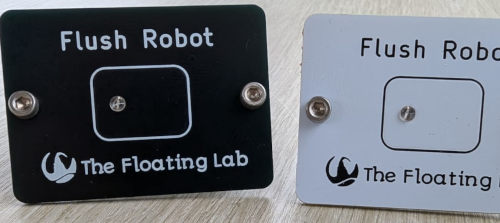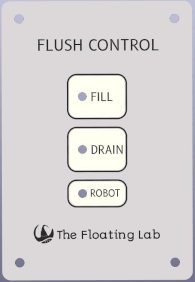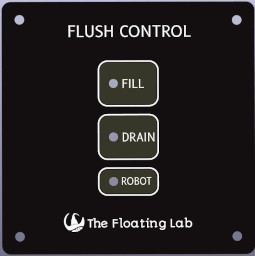
The "Flush Robot" can be installed as an add-on module or as part of a total "Flush Control" replacement.
The "Flush Robot" solves one problem, the "Flush Control" solves two problems.
- Clogged and/or smelly hoses
- Clogged and/or smelly blackwater hoses are a common problem on boats. Clogging is the result of mineral deposit buildup and odor is the result of "lingering content" in the hoses. Clogging and smelling can be prevented by making sure that the blackwater hoses are always completely flushed clean after each use.
But here's the problem: it takes a lot of patience and determination to keep flushing the toilet long enough after the content has disappeared from the bowl. Depending on the hose length it can take some time to ensure that the entire hose only contains clear water. Even if you are patient enough, your guests, crew or caretakers might not be that motivated and might neglect or forget to flush long enough. - Failing control switches
- If your current toilet control uses mechanical switches, the question is not if they will fail, but when they will fail. The pumps that are used in a toilet draw quite some power through the switches, and this reduces their lifetimes. Also, mechanical switches are very sensitive to moisture. On ZwerfCat, I had two electric toilets from two different manufacturers, but both had problems with the switches.


The "Flush Robot" solves the first problem, and can be used while keeping the original switches and control panel undisturbed.
If you want to go one step further, you can replace the existing control panel with the "Flush Control" which not only adds the "Flush Robot" to your system but also replaces the existing mechanical switches by touch buttons.
How it works
The Flush Robot senses when the control switches of the toilet are being used. Five minutes after the last activity, it assumes that the toilet is no longer occupied and it first gives a short beep (actually using the drain pump as a loudspeaker), and if no button is pressed to cancel the imminent flush action, it will commence the hose cleaning procedure.
To understand what comes next, you need to know that the Flush Robot can sense if there is any content in the bowl by measuring the electric current going through the drain pump. It will stop the drain pump exactly at the moment the bowl becomes empty.
It will three times fill the bowl with some water and run the drain pump until it senses that the water is gone. This is done to make some "head room" in the lower part of the toilet to make sure there is no dirt left that can dilute the cleaning water in the next step. It will then almost completely fill the bowl, which will then allow the Flush Robot to run the drain pump long enough to really flush out the hoses and leave them filled with clean water.
Optionally, you can configure the Flush Robot to flush the toilet with a tiny bit of water every 3 hours, just to prevent the development of the "rotten egg smell" that could otherwise be the result of decaying plankton that died due to oxygen starvation. Just having the water move a bit through the system at regular intervals will prevent this from happening.
The Flush Control module has the same features as the Flush Robot but in addition also replaces the mechanical switches of your original toilet control panel.
Features
Like most simple solutions the implementation and the idea kept evolving and the end result was no longer simple but feature rich:
Flush Robot
- Very easy to install, the Flush Robot can just be "piggy-backed" over the existing control switches and can be installed out of sight as it has no control buttons of its own.
- Compatible with any toilet with separate fill and drain pumps.
- Compatible with toilets that have an inlet solenoid and require a pressurized water source.
- Compatible with 12V and 24V systems.
- Uses less than 1mA when idle.
- Available in black and white panel colors.
- The hose cleaning flush will be activated automatically 5 minutes after the last button press, and can also be activated manually by double clicking the fill button.
- Because the original installation is not modified, the original toilet panel will keep working even if the Flush Robot would become defect. (Not applicable to Flush Control which replaces the entire panel.)
- Programmable maximum fill level of the bowl.
- Detection of a stalled or malfunctioning drain pump, after which it will deactivate completely to prevent flooding.
- Detection of low battery voltage (<12V or <24V on 24V systems) after which it will stop the automatic flush to protect the battery.
- Detection of internal hardware and software failures after which it will reset itself automatically.
- Detection of external failures resulting in the fill pump running continuously; it will then repeatedly empty the bowl with the drain pump before the bowl can overflow.
Flush Control
The Flush Control has the same features as the Flush Robot, but in addition:
- It replaces your old panel by a new panel with touch buttons. These touch buttons will not wear out.
- Energizing the pumps is achieved with solid state switches that do not arc inside and will not deteriorate over time.
- Detection of "stuck" switches; after 30 seconds of continuous activation the button needs to be released momentarily to allow further activation.
- Apart from the "Fill" and "Drain" buttons (which can also be touched simultaneously) it has a third button for more control over the internal Flush Robot.
Regardless of Flush Robot, any pumps/valves should be closed and depowered in case the boat is left alone for a prolonged amount of time. Catastrophic events like lightning strikes can have unpredictable consequences like uncontrolled fill pump activity which can ultimately sink the boat.
More information
Documentation (Usage & Installation)
Consult the Documentation for more information about the installation and usage of the Flush Robot and Flush Control.
Project background
For more information about the general design philosophy of the projects of TheFloatingLab, please visit the Project Backgrounds page.
Usage
Use and flush the toilet normally. FlushBot is not designed to completely take over the flushing process - without getting into details - the flush process is different with every single use. After the manual flush cycle, ensuring that only clear water remains in the bowl, it is time for FlushBot to do its job. Double-click on the flush button and walk away. Or, even don't do anything at all and just walk away. In the latter case, FlushBot will 5 minutes after the last button-press automatically initiate its flush sequence.
A flush sequence can any time be aborted by pressing one of the buttons.
Ordering
We are ordering a few completely assembled units. If you are interested, let us know and we will put you on the list.